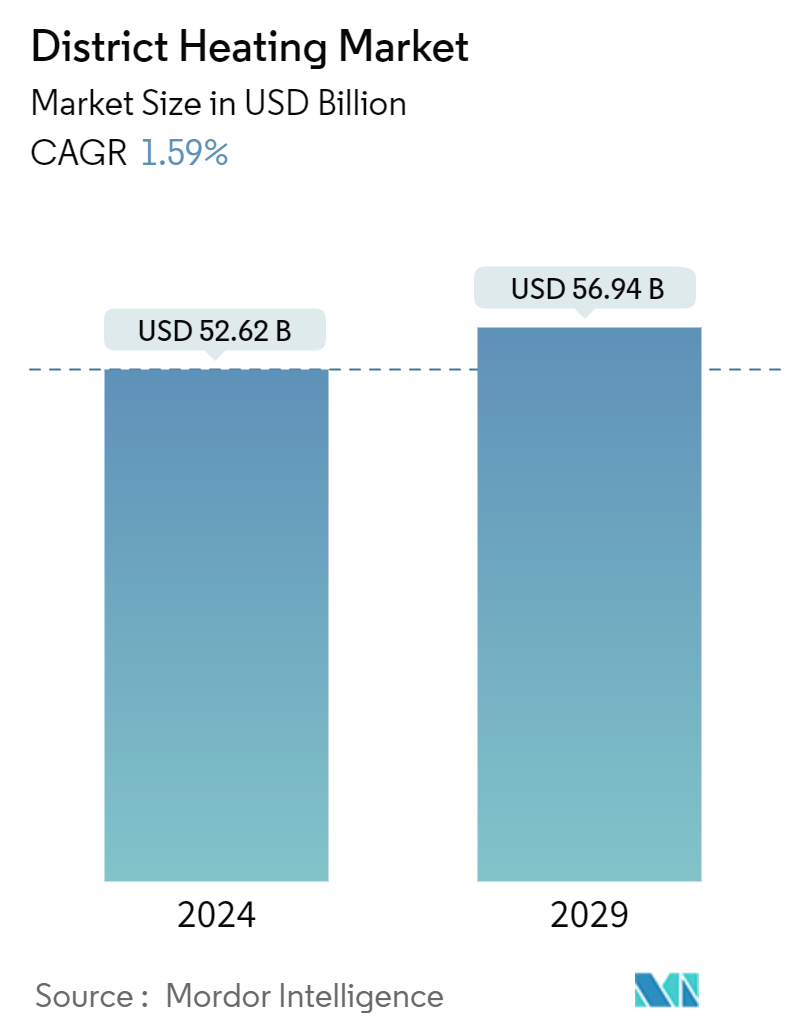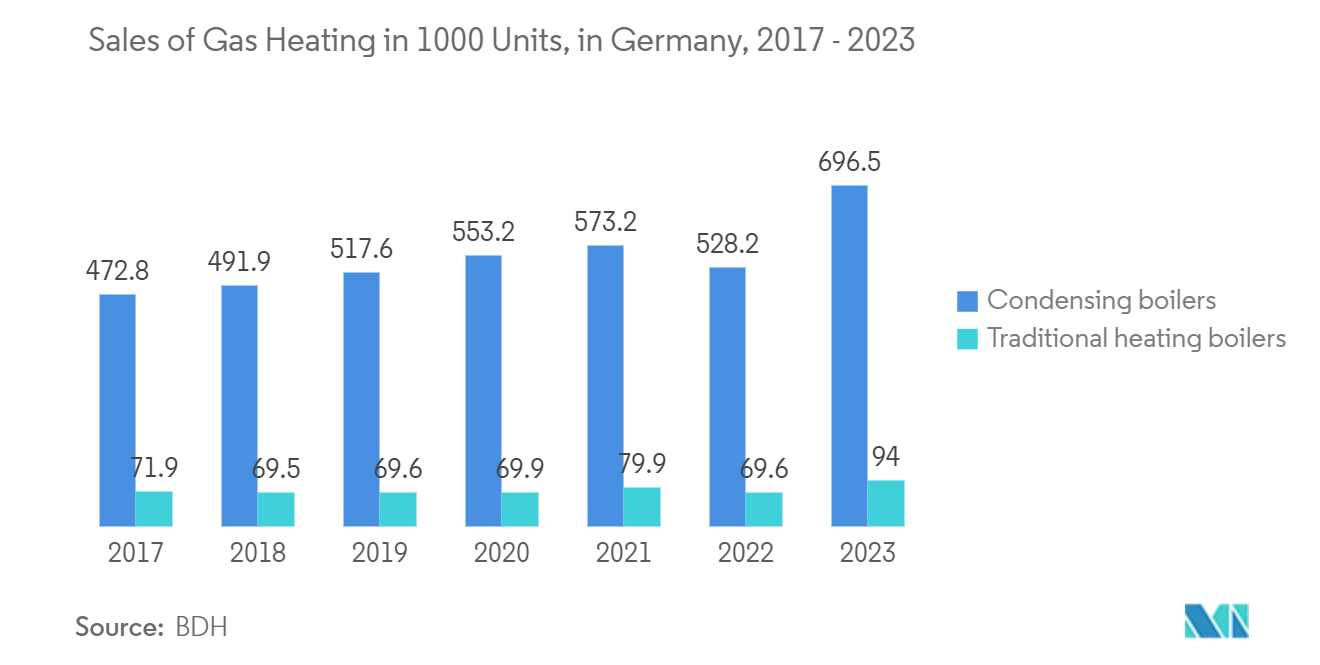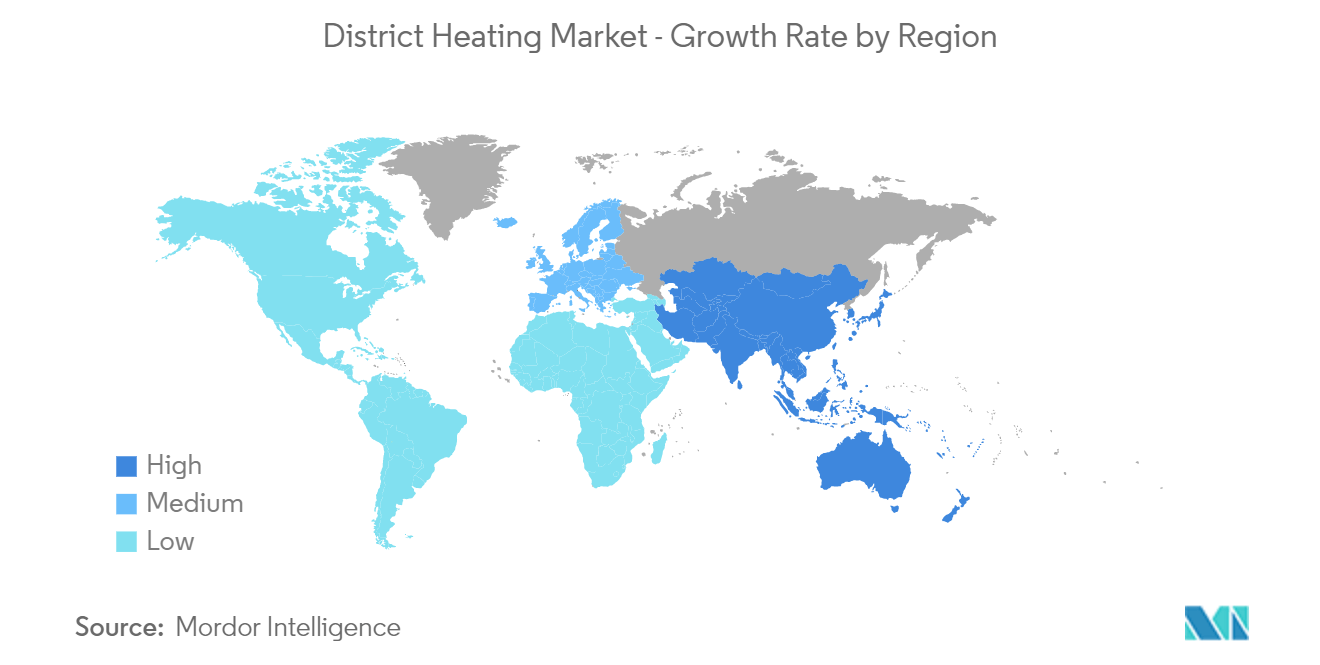District Heating Market Size

| Study Period | 2019 - 2029 |
| Market Size (2024) | USD 52.62 Billion |
| Market Size (2029) | USD 56.94 Billion |
| CAGR (2024 - 2029) | 1.59 % |
| Fastest Growing Market | Asia Pacific |
| Largest Market | Asia-Pacific |
Major Players
*Disclaimer: Major Players sorted in no particular order |
District Heating Market Analysis
The District Heating Market size is estimated at USD 52.62 billion in 2024, and is expected to reach USD 56.94 billion by 2029, growing at a CAGR of 1.59% during the forecast period (2024-2029).
District energy is a quick-growing industry globally, supported by the aggressive climate objectives set by the global economies. Based on initial assessments, these district heating and cooling companies have been recognized as operations that could produce more extraordinary growth and value potential with an alternative holding structure. By including electrically powered heat pumps in the district heating supply, higher renewable energy levels can be used for thermal purposes, generating integration and balance between energy systems. With a burgeoning global wind turbine capacity, big heat pumps will play a meaningful role in the sustained global green energy development and phasing out fossil fuels by 2050.
- District heating provides a method of delivering thermal energy to buildings (homes and commercial space) in the form of hot water through a distribution network of highly insulated pipelines. The potential for increased use of industrial district heating is limited because conversions of industrial processes to district heating involve varying heat loads amongst types of industries and processes.
- However, the conversion to district heating serves an 11% reduction in the use of electricity and a 40% reduction in the use of fossil fuels, with a total energy end-use saving of 6% among industries.
- Converting the industrial processes has led to a potential reduction of global carbon dioxide emissions by 112,000 tons per year. However, the residential and commercial markets are expected to hold a significant share.
- Approximately 60 million EU citizens are served by district heating, and an additional 140 million people live in cities with at least one district heating system. According to reports by the EU and the IEA, DH meets around 11-12% of the EU's heat demand via 6,000 district heating and cooling networks.
- With machine learning, the idea is to predict heat loads from customer data and operational data, along with weather forecasts, national holidays, weekdays, etc., to optimize and plan heat production, thereby lowering heat loss and handling peak loads. The potential is extended to intelligent algorithms in fault detection to identify leakages, inefficient heating systems, or errors from failure related to single components.
- In June 2024, Swedish SMR project developer Kärnfull Next has strategically partnered with Finnish counterpart Steady Energy to introduce SMRs for district heating in Sweden. The collaboration aims to capitalize on Kärnfull's unique financing structures and delivery models to introduce Steady Energy's renowned district heating reactors to the Swedish market.
District Heating Market Trends
Residential to Witness the Growth
- District heating is commonly used in industrialized nations worldwide. It has several advantages over individual building equipment, including improved safety and dependability, lower emissions, and greater fuel flexibility, particularly when utilizing alternative fuels such as biomass or garbage.
- District heating is widely utilized in single-family houses, multi-family dwellings, high-rise buildings, and mega townships. The primary home uses that require district heating are space and water heating. District heating markets are well-established in several cold-climate nations, such as Denmark, Iceland, Germany, the United States, other EU countries, and Canada.
- However, the District heating networks powered by renewable energy sources may significantly reduce emissions and help governments meet their emission reduction objectives. Various governments have established statutory responsibilities and incentives, such as grants, subsidies, and energy taxes, to boost the percentage of renewables in heat generation.
- Moreover, District heating was previously primarily powered by byproducts of power plants, waste-to-energy facilities, and industrial activities. However, Sweden is now incorporating more renewable energy sources into the mix. Due to competition, this localized kind of electricity has risen to the national top home-heating industry.
- According to BDH, in 2023, Germany saw sales of approximately 790,500 gas heating systems. Among these, approximatly 94,000 employed traditional low-temperature technology, with the majority, over 696,500, opting for condensing boiler technology.

Asia-Pacific Holds a Significant Share in the District Heating Market
- The primary reasons driving the market's growth in China are rising disposable income, increased worries about CO2 emissions, and high usage of heating and cooling systems. Moreover, OECD states that projections for India and China's per capita GDP might climb sevenfold by 2060.
- Governments in the Asia-Pacific region are also collaborating with local businesses to develop the home market. For example, the Beijing District Heating Group is a major heating firm in China. The firm provided heating solutions to the central Beijing government and army, Chinese embassies, significant corporations and organizations, and the general people. It also has a large number of projects in other provinces.
- Modern district heating systems are especially important for Southeast Asian countries, where air pollution causes long-term economic expenses and hundreds of thousands of premature fatalities. The Future of Cooling in Southeast Asia investigates the anticipated growth in energy consumption, peak power demand, and CO2 emissions by 2040.
- India and Australia are two of the region's biggest marketplaces. The regional market is rising due to increased investment in district heating and cooling solutions and increased government activities to promote these solutions.
- To respond to energy crises and climate change, the South Korean government established a national plan to promote zero energy buildings, and several energy efficiency policies for new and existing buildings in recent years have been developed to achieve these plans.

District Heating Industry Overview
The district heating market is moderately competitive and has many global and regional players. These companies are working hard to broaden their consumer base globally. To gain a competitive advantage during the predicted term, they also prioritize R&D expenditure in developing innovative solutions, strategic collaborations, and other organic and inorganic growth tactics.
In May 2023, Vattenfall AB and Coca-Cola announced the collaboration in Sweden and have set ambitious climate targets for net zero emissions across their entire value chains by 2040. The companies have initiated a pilot project with three charging stations to meet the need for powering electric transport.
In March 2023, NRG Energy Inc completed its acquisition of Vivint Smart Home, Inc. by accelerating NRG's consumer-focused growth strategy and offering consumers simple, connected experiences to power, protect, and manage their homes intelligently. NRG is at the intersection of energy and home services, with a unique end-to-end smart home ecosystem underpinned by our exceptional customer experience.
District Heating Market Leaders
-
Vattenfall AB
-
Danfoss Group
-
SP Group
-
Engie
-
NRG Energy Inc.
*Disclaimer: Major Players sorted in no particular order

District Heating Market News
- April 2023: Danfoss Group announced the new options for OEMs as it expands the Z-design range of Micro Plate Heat Exchangers; where The latest addition to the range C262L-EZD is a dual-circuit evaporator that's ideal for scroll chillers. These robust and reliable units extend the range's capability with cooling capacities now covering up to 300 kW in single circuits and up to 800 kW in dual circuits.
- October 2022: ENGIE announced it acquired a 6 GW portfolio of solar, paired and stand-alone battery storage development projects from Belltown Power U.S. The transaction included 33 projects comprising some 2.7 GW of Solar with 0.7 GW of paired storage and 2.6 GW of stand-alone battery storage. The projects across ERCOT, PJM, MISO and WECC1 and ENGIE will increase grid stability and resilience by integrating green power generation with paired and stand-alone storage.
District Heating Market Report - Table of Contents
1. INTRODUCTION
- 1.1 Study Assumptions and Market Definition
- 1.2 Scope of the Study
2. RESEARCH METHODOLOGY
3. EXECUTIVE SUMMARY
4. MARKET INSIGHTS
- 4.1 Market Overview
-
4.2 Industry Attractiveness - Porter's Five Forces Analysis
- 4.2.1 Bargaining Power of Suppliers
- 4.2.2 Bargaining Power of Consumers
- 4.2.3 Threat of New Entrants
- 4.2.4 Threat of Substitute Products
- 4.2.5 Intensity of Competitive Rivalry
- 4.3 Industry Value Chain Analysis
- 4.4 Impact of COVID-19 on the Market
- 4.5 Government Initiatives and Programs on District Heating Transition
- 4.6 Key Trends and Innovations in District Heating
5. MARKET DYNAMICS
-
5.1 Market Drivers
- 5.1.1 Augmented Demand for Energy-efficient and Cost-effective Heating Systems
- 5.1.2 Rising Urbanization and Industrialization
-
5.2 Market Restraints
- 5.2.1 High Infrastructure Cost
6. MARKET SEGMENTATION
-
6.1 By Plant Type
- 6.1.1 Boiler
- 6.1.2 Combined Heat and Power (CHP)
-
6.2 By Heat Source
- 6.2.1 Coal
- 6.2.2 Natural Gas
- 6.2.3 Renewables
- 6.2.4 Oil and Petroleum Products
-
6.3 By Application
- 6.3.1 Residential
- 6.3.2 Commercial and Industrial
-
6.4 By Geography***
- 6.4.1 North America
- 6.4.2 Europe
- 6.4.3 Asia
- 6.4.4 Australia and New Zealand
- 6.4.5 Latin America
- 6.4.6 Middle East and Africa
7. COMPETITIVE LANDSCAPE
-
7.1 Company Profiles*
- 7.1.1 Vattenfall AB
- 7.1.2 SP Group
- 7.1.3 Danfoss Group
- 7.1.4 Engie
- 7.1.5 NRG Energy Inc.
- 7.1.6 Statkraft AS
- 7.1.7 Logstor AS
- 7.1.8 Shinryo Corporation
- 7.1.9 Vital Energi Ltd
- 7.1.10 Gteborg Energi
- 7.1.11 Alfa Laval AB
- 7.1.12 Ramboll Group AS
- 7.1.13 Keppel Corporation Limited
- 7.1.14 FVB Energy
8. INVESTMENT ANALYSIS
9. FUTURE OPPORTUNITIES
** Subject To AvailablityDistrict Heating Industry Segmentation
District heating (also recognized as heat networks or teleheating) is a system for distributing heat produced in a centralized place through insulated pipes for domestic and commercial heating necessities, such as water heating and space heating. The district heating system comprises a high-powered central boiler, well-insulated pipes hidden under the streets, a heat exchanger, and an added system (heat pump, solar power, boiler, etc.) to generate hot water separately in the summertime.
The district heating market is segmented by plant type (boiler plant, combined heat and power (CHP)), heat source (coal, natural gas, renewables, oil, and petroleum products), by application (residential, commercial, and industrial), and by geography (North America, Europe, Asia Pacific, Rest of the World). The report offers market forecasts and size in value (USD) for all the above segments.
| By Plant Type | Boiler |
| Combined Heat and Power (CHP) | |
| By Heat Source | Coal |
| Natural Gas | |
| Renewables | |
| Oil and Petroleum Products | |
| By Application | Residential |
| Commercial and Industrial | |
| By Geography*** | North America |
| Europe | |
| Asia | |
| Australia and New Zealand | |
| Latin America | |
| Middle East and Africa |
District Heating Market Research FAQs
How big is the District Heating Market?
The District Heating Market size is expected to reach USD 52.62 billion in 2024 and grow at a CAGR of 1.59% to reach USD 56.94 billion by 2029.
What is the current District Heating Market size?
In 2024, the District Heating Market size is expected to reach USD 52.62 billion.
Who are the key players in District Heating Market?
Vattenfall AB, Danfoss Group, SP Group, Engie and NRG Energy Inc. are the major companies operating in the District Heating Market.
Which is the fastest growing region in District Heating Market?
Asia Pacific is estimated to grow at the highest CAGR over the forecast period (2024-2029).
Which region has the biggest share in District Heating Market?
In 2024, the Asia-Pacific accounts for the largest market share in District Heating Market.
What years does this District Heating Market cover, and what was the market size in 2023?
In 2023, the District Heating Market size was estimated at USD 51.78 billion. The report covers the District Heating Market historical market size for years: 2019, 2020, 2021, 2022 and 2023. The report also forecasts the District Heating Market size for years: 2024, 2025, 2026, 2027, 2028 and 2029.
District Heating Industry Report
Statistics for the 2024 District Heating market share, size and revenue growth rate, created by Mordor Intelligence™ Industry Reports. District Heating analysis includes a market forecast outlook to 2029 and historical overview. Get a sample of this industry analysis as a free report PDF download.



